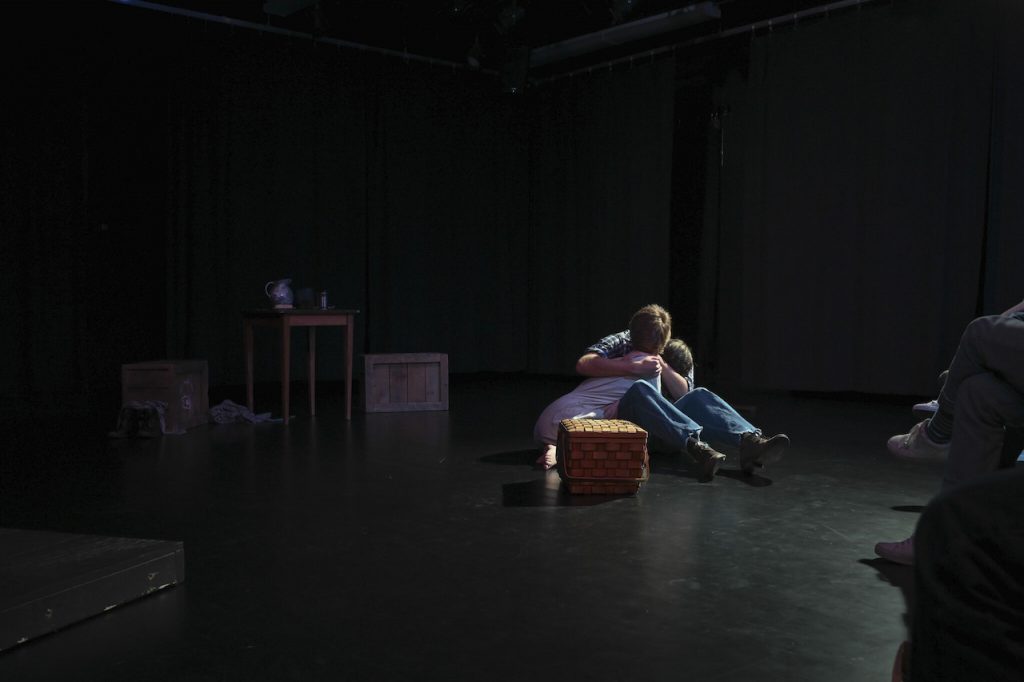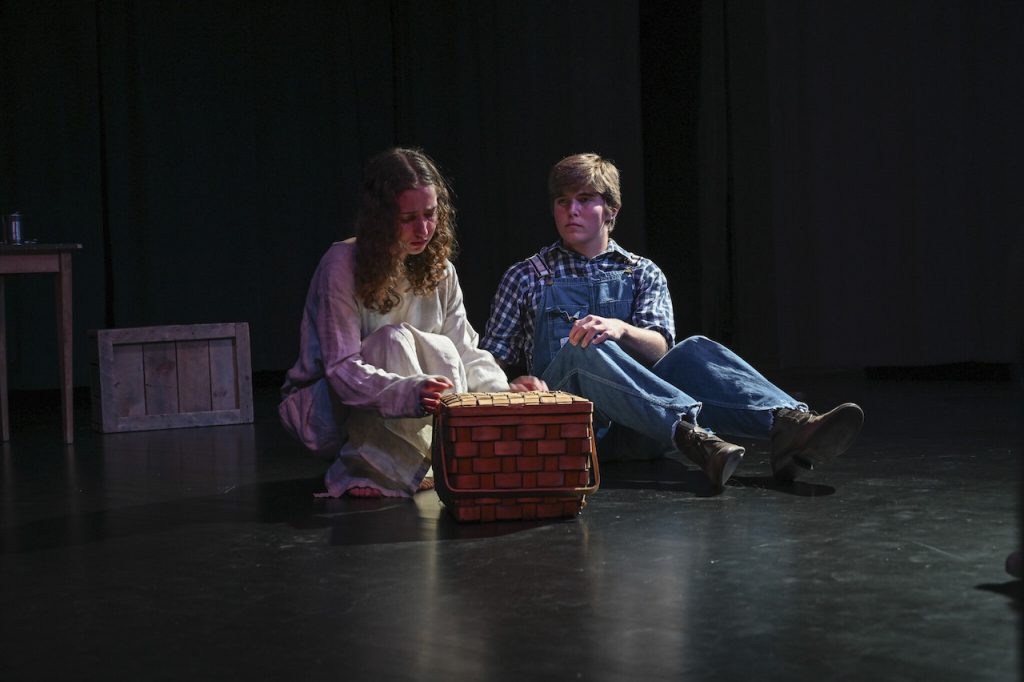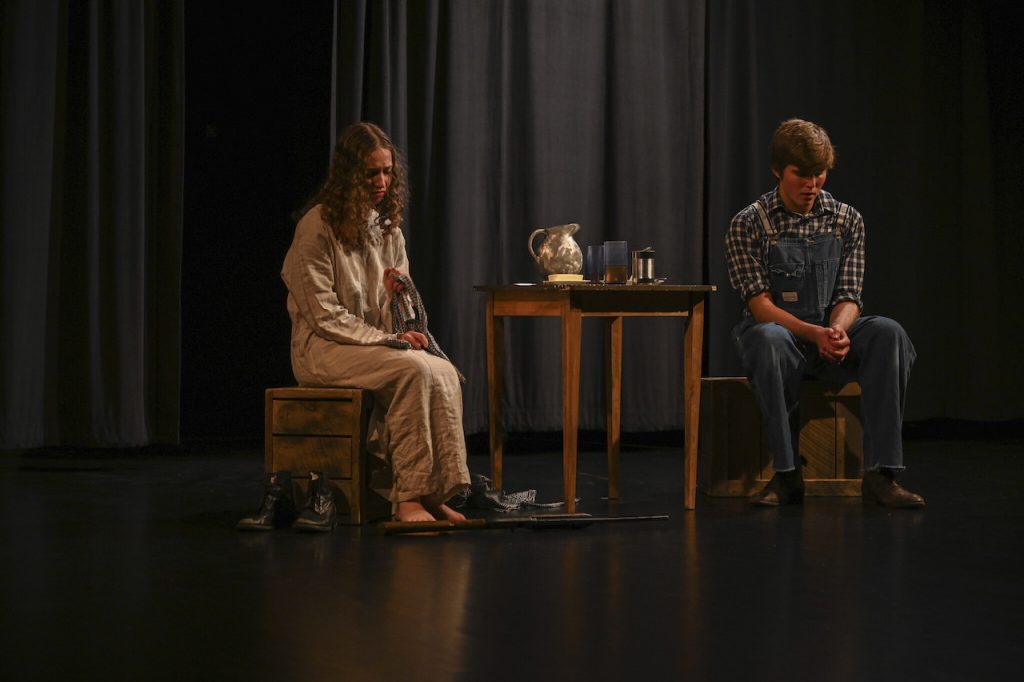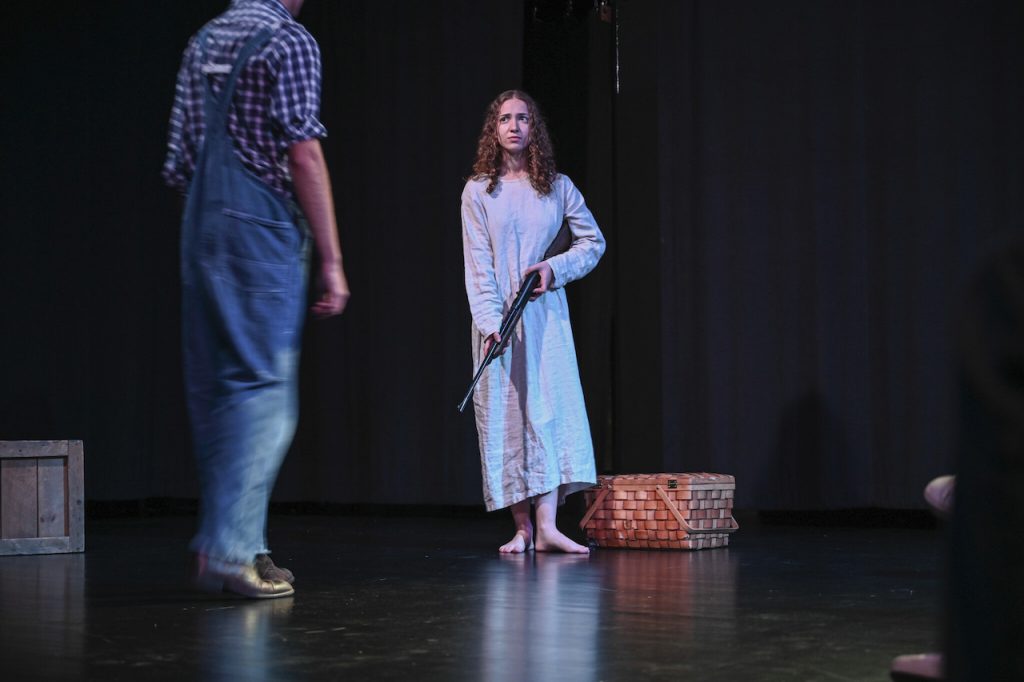BY ELLERY SHEA ’25

On one of the first chilly nights of the season, I approached the gentle ambiance of Studio A for this semester’s second studio lab, Heart in the Ground, written by Douglas Hill and directed by Stephanie Kemple ’25. Just as I entered the room, I was alerted that seating had been extended onto the floor. In recognition of the packed house, I opted for the close-up view from one of the mats on the ground.
As soon as the house lights dimmed, the show began. Lights come up on Karen, portrayed by Becca Durst ’27 and Lee, played by Tommy Cattalani ’28, as they stand in a room with an intimate dinner table with two crates for chairs. Karen and Lee are partners grieving the recent death of their newborn daughter Catherine, although Karen appears to be acting upon her grief much more than Lee is. At the start of the show, Karen has just dug up the grave of their deceased daughter for the second time and brought her back to their home. After arriving home, Karen prepares a meager dinner of bread, butter, and water for her and Lee. Lee is upset with her about this, and when he takes his seat, he begins to complain to Karen that her obsession has made her unable to fulfill her household responsibilities.
He justifies his anger by telling Karen that as soon as her brother Bill (who also happens to be the town sheriff) sees the hole dug up in the cemetery, he will be at their home giving them trouble. Fearing Bill’s response, Lee pleads for Karen to “Just stay away from the cemetery and take care of things here” in the future, but Karen expresses that she is unable to concentrate on the work he wants her to do. Despite Karen’s protests, Lee asserts that they can’t bury her at their home because they live too close to the river, and “there’s not a blessed thing [they] can do about it.” While Lee butters his bread and chows down on it, he urges Karen to join him. Instead, Karen finds refuge in speaking about the stories her mother used to tell her about the full moon, its beauty, and its ability to make things grow. Despite Lee’s disinterest, she continues to speak and takes off her black work boots because she “can’t feel anything” with them on, and “it’s hard to know what to do sometimes when you can’t feel what’s beneath you.”
Lee remains indifferent to his partner’s feelings. Interrupting Karen’s reprieve, Lee suggests that she stay upstairs when Bill arrives. When Karen insists that it’s her house and that Bill is “gonna have to look me in the eye before he walks out of here with her,” Lee insists that he’ll “handle it” by himself. Lee reveals that he supports her and would change the law if he had any control over it, but insists on complying with Bill so that they are not tossed out of town. The unchanging lights tune us into the harsh reality of their environment and allow the dynamics of their voices to do the storytelling.
Not only do the tones of their voices do extensive storytelling, but the information they reveal as well. Karen gets up and begins to exit, but Lee begs for her to stay, because if Bill sees her in her current state she may be taken back to Green Valley, a psychiatric care facility she was once sent to. Karen’s retort reveals the true reason of her brother’s micromanagement: “He wants this farm. It doesn’t have anything to do with my sanity or an empty grave.” Karen then exits, which provokes Lee to chuck his remaining bread at the wall, which memorably stuck to the curtain of Studio A for quite some time.

While Lee steps back from the dinner table and composes himself, Karen re-emerges from behind the curtain of Studio A carrying a shotgun. This entrance felt particularly powerful; not only was the audience witnessing a gun on stage in a very intimate space, but the juxtaposition between the gun and the otherwise domestic surroundings emphasized the stakes that Karen’s situation carries for her.
This juxtaposition dramatically upped the intensity of the tension onstage. Karen does not point the gun at Lee, but rather keeps it poised up, perhaps making Lee worry that if she were to use it, that she might use it on herself. Motivated by a new fear, Lee apologizes to her. Lee then tells her to put away the gun, on account of it not being loaded, but Karen retaliates by telling him she knew the shells were hidden in with their Christmas decorations and thought ahead to load it. Karen then questions, “Why don’t you want her here with us?” and Lee’s response reveals to the audience that he’s on parole, which he denies having any part in his fear of Bill. Before exiting the dining room, Karen shames him for his inability to recognize how his own fears are being projected onto her circumstances.

The lights come down and dim lighting with cooler tones show a minimalistic platform being brought downstage. The sound of cicadas and other evening creatures hum nearby. Karen and Lee step out onto the porch. Now on the back porch with the shotgun still in her hands, Karen defends the small wooden box containing her daughter’s body. Lee warns her that they can’t be seen breaking the law, but Karen holds her ground, insisting that right now she is the only one breaking the law.
However, Lee remains unsupportive of Karen and her defiant autonomy, ordering her to give him the gun. When she refuses, he takes the box instead. Then, when Lee moves the box elsewhere, Karen drops the shotgun and races for the box. When Karen takes the box in defense, Lee seizes the shotgun. He then fires it away from her, which causes Karen to impulsively cover the box with her body. At this point, the spatial rift between Karen and Lee was larger than any other time in the play. The lighting choices emphasized this rift: Lee’s side of the stage was shrouded in cool lighting, while Karen and the area surrounding the box radiated warmth and life. Lee once again orders Karen to go inside and hide from Bill.
Karen continues to maintain her defiance. Still guarding the box, she launches into a heartwrenching monologue which reminds Lee that Bill is not his family – she and Catherine are. She then reflects on how lucky both she and Lee are to have the farm after his parole and her time at Green Valley. Finally, she reveals the reality of her another pregnancy she had in her teenage years, which is why she inherited the farm to begin with – a detail that even Lee did not know previously. These moments are intensely cathartic for both characters, and the emotional extremes portrayed by Durst and Cattalani are impressive. Despite how late into the play we are, we are learning new information with every beat.
Following this moment, Lee lowers the shotgun, departs his side of the stage and joins Karen by the box. They embrace, and Lee quietly concedes that there is a way they can keep Catherine on the farm. In this moment of tenderness on the floor, I felt so affected to see them united for the first time in the entire play. Watching them standing and arguing while I sat on a mat on the ground made me feel as if I were the ghost of their child, tied to the ground, looking up at their disagreement, and when they finally they finally joined together on the ground, the resolution sense of togetherness was overwhelming moving. Kemple’s expert directorial choice to allow audiences to sit on the ground emphasizes the environmental stakes of the world of the play.

Karen gathers corn offstage and they replace their child bundled up in a beautiful pink blanket with a bunch of corn. After sealing the corn shut in the box, Lee removes his shoes and socks, demonstrating that he finally understands where Karen is coming from. They leave the box full of corn on the porch for Bill to find and then exit together, Lee carrying a shovel so that they may bury their baby without the intervention of others.
Though it ultimately takes a major spectacle for Lee to understand Karen’s perspective, the play maintains the importance of listening to one another carefully through its subtle reveals of surrounding context. Just as Lee learns, we learn. Heart in the Ground floored me: through minimalistic and thoughtful stage images, lighting design, usage of props, and incredibly dynamic performers, Kemple’s powerful directorial vision comes to life, and delivers love.
